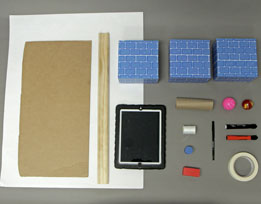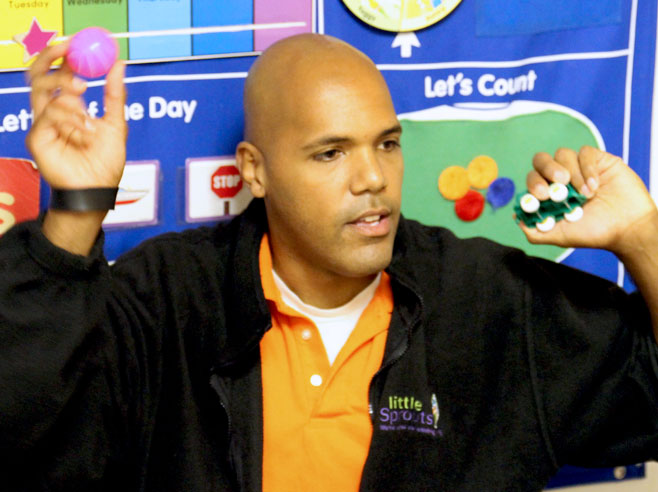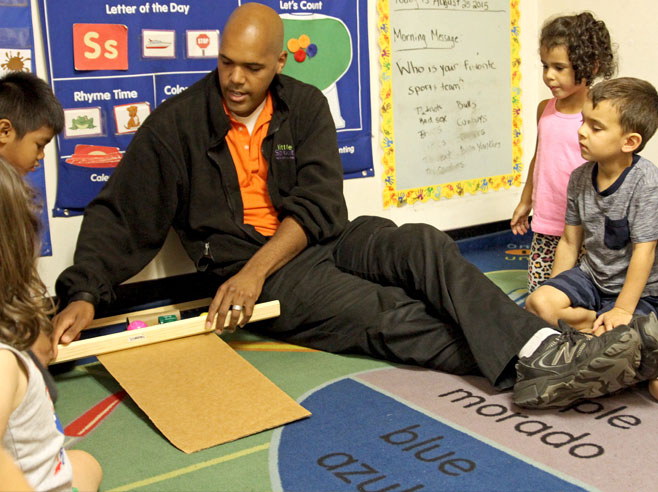Children send two objects down a single ramp to find out which one rolls faster. They predict what will happen if they increase the steepness of the ramp. Will the same object still be faster?
Materials

- Slow It Down Videos tool in the digital Ramps Journal on 1 or more iPads (Ideally, use a different iPad for each Guided Small Group.)
- Blocks to prop up the ramp
- Chart paper and markers (2 colors)
- Objects to roll down the ramp, such as a ball, cardboard toilet paper tube, big marble, roll of tape, spool, simple pen with no clip, cylindrical block, or similar objects
- Ruler or unsharpened pencil, to serve as a “starting gate”
- Wide cardboard ramp with a starting line drawn 2″ from the top edge
- Yardstick, to serve as a finish line (A wall can also serve as the finish line.)
Preparation
- Write the title Which Is Faster? at the top of the chart paper.
- Draw a starting line 2 inches from the top edge of the cardboard ramp.
- Experiment with the objects and the ramp to make sure all objects roll in a fairly straight line.
- Consider using a different iPad for each Guided Small Group. This means that each iPad will have Which Is Faster? Slow It Down videos that children can revisit independently at the Learning Center.
- Make sure the iPads are charged and the volume adjusted appropriately.
Directions: Lesson 5
Guided Small Group
- Display the set of objects and ask, Do you predict these objects will roll or slide down a ramp? Why do you think that?
- Let the group choose two objects to send down the ramp in their first trial run. Draw pictures of the two objects in the top row of the chart, under the question, Which Is Faster?
- Let children make predictions by writing a check mark or their initial by the object they think will be faster and explain why they think that.
- Have children help you set up a low, gentle ramp. Use the yardstick as the finish line (place it approximately 1 foot in front of the bottom of the ramp) or make the ramp face a wall and let the wall serve as the finish line.
- Help one child place the two objects on the starting line at the top of the ramp, behind a “starting gate” ruler. The child will raise the starting gate when the rest of the group says, “Ready? Set? Go!” Remind children to observe carefully to see which object is first to reach the finish line.
- Which object was faster? How do you know that object was faster?
- Run the race again to see if the results are the same. Draw attention to the question and predictions on the chart. Ask a child to circle the picture of the object that was faster. Possible discussion ideas:
- What do you think will happen if we make the ramp steeper and send the same two objects down the ramp?
- Which object do you think will reach the finish line first? Let children enter their predictions on the chart, using a different-colored marker.
- Help children add more blocks to make the ramp steeper, then run the experiment following the same steps as before.
- One child will be responsible for raising the starting gate and releasing the two rolling objects.
- Choose a second child to video record the experiment on the iPad, using the Slow It Down Videos tool in the digital Ramps Journal. Help the videographer stand so the ramp and roll-out area fill the frame of the iPad from left to right. You may want to hold the iPad steady and let the child tap the video button to record. Once the video button is tapped, the app provides an audio prompt for raising the starting gate— Ready? Set? Go!—and begins to record as it says “Go!”
- Which object was faster? How do you know it was faster? Watch the slow-motion video to verify the answer.
- Draw attention to the predictions on the chart. Ask a child to use the second color marker to circle the picture of the object that rolled the fastest down the steeper ramp. Were our predictions correct?
- Optional: Have children adjust the ramp to be low and gentle again. Have them choose two new objects to send down the ramp. Draw the items in a second row on the chart and let children predict which object they think will be faster and explain why they think that. Follow the steps above, first testing which object rolls faster down the gentle ramp, and then predicting and testing whether the same object rolls faster down a steeper ramp. Let children take turns raising the starting gate and video recording the experiments.
Learning Center
- Invite children to rewatch the Which Is Faster? Slow It Down videos taken by themselves and other children. Remind them to observe what happens closely.
- As you stop by this center, engage children in conversation about which objects they observe going faster and how they know which one is faster. Use similar prompts as in the Guided Small Group activity.
Directions: Lesson 6
Learning Center
- Invite children to rewatch the Which Is Faster? Slow It Down videos taken by themselves and other children. Remind them to observe what happens closely.
- As you stop by this center, engage children in conversation about which objects they observe going faster and how they know which one is faster. Possible discussion ideas:
- Which object was faster? How do you know that object was faster?
- What do you think will happen if we make the ramp steeper and send the same two objects down the ramp?
- Which object do you think will reach the finish line first? Let children enter their predictions on the chart, using a different-colored marker.


